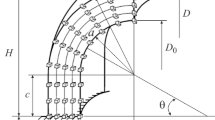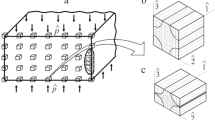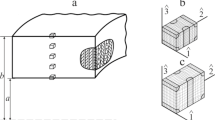Form changes of a cross-reinforced toroidal body under butt-end torsion and rotation are investigated on the basis of carcass theory of fibrous media at large deformations, including macro- and micromechanical levels of analysis. The form changes are considered as the result of external loadings specified by the field of carcass displacements. This field, which is an integral manifestation of internal fields of the body during its deformation, is determined on the macrolevel. The internal fields are found by solving boundary-value problems on the micromechanical level for the nodal blocks of material on the basis of the model of a piecewise homogeneous medium. Configurations of the body at the values of torsion angle and rotational speed close to limiting ones are presented. The configurations of material blocks in the deformed body, which reflect its internal fields, are illustrated. The regions of folding in the binder close to butt-end sections, where the body is connected with nondeformable shafts, are revealed.





Similar content being viewed by others
References
V. M. Akhundov, “Structural macroscopic theory of stiff and soft composites. Invariant description,” Mech. Compos. Mater., 34, No. 5, 419-432 (1998).
V. M. Akhundov, “Carcass theory of rigid and soft composites with uncurved and curved structures. Invariant description,” Mekh. Kompos. Mater. Strukt., 6, No. 2,275-293 (2000).
V. M. Akhundov, “Carcass theory of fibrous media with uncurved and locally curved fibers at large deformations,” Mech. Compos. Mater., 51, No. 6, 683-694 (2015).
N. Takano, Y. Ohnishi, M. Zako, and K. Nishiyabu, “The formulation of homogenization method applied to large deformation problem for composite materials,” Int. J. of Solids and Structures, 37, 6517-6535 (2000).
V. M. Akhundov, “Applied theory of composites sparcely filled with strings at large deformations,” Mekh. Kompos. Mater. Strukt. 7, No. 1, 3-15 (2001).
S. Klinkel, C. Sansour, and W. Wagner, “An anisotropic fiber-matrix material model at finite elastic-plastic strains,” Comput. Mech., 35, 409-417 (2005).
T. D. Nguyen, R. E. Jones, and B. L. Boyce, “Modeling the anisotropic finite-deformation viscoelastic behavior of soft fiber-reinforced composites,” Int. J. of Solids and Structures, 44, 8366-8389 (2007).
V. M. Akhundov, “Structural theory of elastomeric composites based on fiber systems. Invariant description,” Mech. Compos. Mater., 32, No. 2, 156-175 (1996).
F. Tabaddor and J. R. Stafford, “Some aspects of rubber composite finite element analysis,” Computers and Structures, 21, No.1-2, 327-339 (1985).
V. M. Akhundov, “Design of momentless shells of revolution made of fiber-reinforced elastomeric layers,” Mech. Compos. Mater., 30, No. 2, 183-189 (1994).
S.-Y. Luo and A. Mitra, “Finite elastic behavior of flexible fabric composite under biaxial loading,” J. Appl. Mech., 66, 631-638 (1999).
G. A. Holzapfel, T. C. Gasser, and R. W. Ogden, “A new constitutive framework for arterial wall mechanics and a comparative study of material models,” J. of Elasticity, 61, 1-48 (2000).
W. J. Poole, J. D. Embury, S. MacEwen, and U. F. Kocks, “Large strain deformation of a copper-tungsten composite system. 1. Strain distributions,” Phil. Mag. A., 69, No. 4, 645-665 (1994).
S. Sockalingam, J. W. Gillespie, and M. Keefe, “On the transverse compression response of Kevlar KM2 using fiberlevel finite element model,” Int. J. of Solids and Structures, 51, 2504-2517 (2014).
V. M. Akhundov, “Analysis of elastomeric composites based on fiber-reinforced systems. 1. Development of design methods for composite materials,” Mech. Compos. Mater., 34, No. 6, 515-524 (1998).
V. M. Akhundov, “Modeling large deformations of fibrous bodies of revolution based on applied and carcass theories. 1. Butt-end torsion of cylindrical and toroidal bodies,” Mech. Compos. Mater. 50, No. 2, 245-256 (2014).
G. A. Korn and T. M. Korn, Mathematical Handbook for Scientists and Engineers: Definitions, Theorems and Formulas for Reference and Review, N.Y., General Publ. Company, 2000, 1151 p.
F. L. Chernousko and V. P. Banichuk, Varionational Problems of Mechanics and Management [in Russian], M., Nauka, 1973, 238 p.
Finite-Element Method in the Mechanics of Solid Bodies [in Russian], eds. A. S. Sakharov and I. Altenbakh, Kiev, Vishcha Shkola, 1982, 480 p.
F. P. Vasil’ev, Numerical Methods of Solution of Extremal Problems [in Russian], M., Nauka, 1988, 552 p.
V. L. Biderman, R. L. Guslitser, S. P. Zakharov, B. V. Nenakhov, I. I. Seleznev, and S. M. Cukerberg, Automobile Tires [in Russian], M., Goskhimizdat, 1963, 384 p.
M. Levinson and I. W. Burgess, “A comparison of some simple constitutive relations for slightly compressible rubberlike materials,” Int. J. Mech. Sci., 13, 563-572 (1971).
P. J. Blatz, “Application of finite elastic theory in predicting the performance of solid propellant rocket motors,” Calif. Inst. of Techn. GALCJISM, 1960, 60-125.
V. M. Akhundov, “Analysis of elastomeric composites based fiber-reinforced systems. 3. Two-directional composites,” Mech. Compos. Mater. 35, No. 4, 325-334 (1999).
A. I. Lur’e, Nonlinear Elasticity Theory [in Russian], M., Nauka, 1980, 512 p.
D. E. Forsythe, M. A. Malcolm, and C. B. Moler, Computer Methods for Mathematical Computations, N.Y: Prentice-Нall, Inc. Еnglewood Сliffs, 1977.
V. E. Mikhalenko and A. M. Ponomarev, Engineering Graphics [in Russian], Kiev, Vishcha Shkola, 1990, 303 p.
Author information
Authors and Affiliations
Corresponding author
Additional information
Translated from Mekhanika Kompozitnykh Materialov, Vol. 53, No. 2, pp. 359-378 , March-April, 2017.
Rights and permissions
About this article
Cite this article
Akhundov, V.M. Form Changes of a Toroidal Body with a Crossed Arrangement of Fibers on the Basis of the Two-level Carcass Theory. Mech Compos Mater 53, 253–266 (2017). https://doi.org/10.1007/s11029-017-9658-8
Received:
Revised:
Published:
Issue Date:
DOI: https://doi.org/10.1007/s11029-017-9658-8




